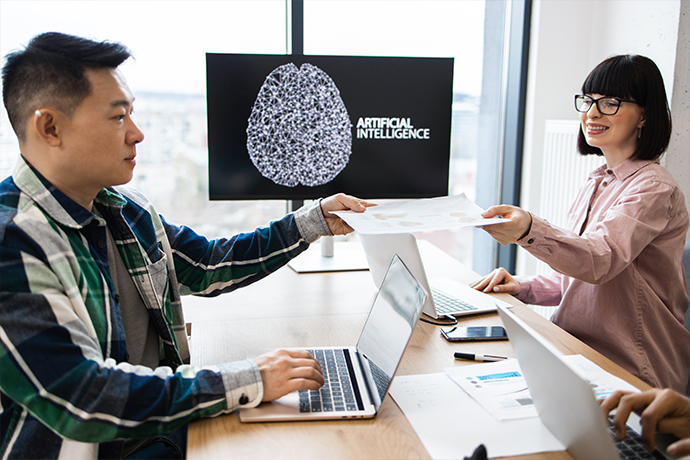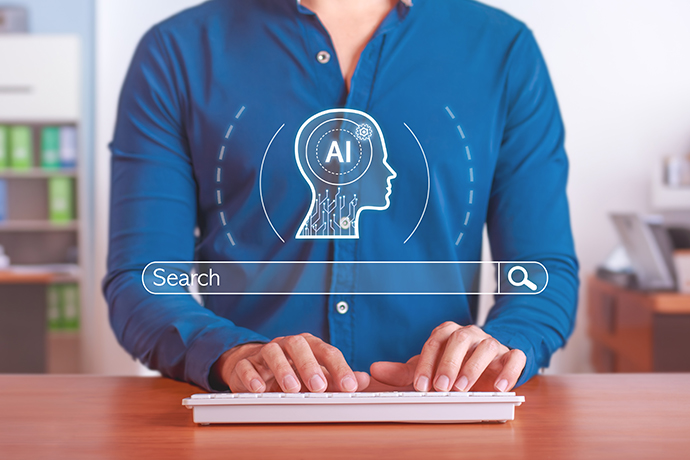 SPEAKERS
SPEAKERS
Discover how to adapt to a world of AI with our guide for business owners. Learn how to deal with employee resistance, how to choose the right AI tools, and overcome any challenges that might arise.

Change is inevitable, but growth is optional. Today, change is on our doorsteps. Artificial intelligence is already making its mark, changing how businesses operate. It's about time we embrace this change.
Technological innovations have been known to cause disruptions in industries. This disruption leaves businesses that were once industry leaders such as Nokia on the verge of being obsolescent. AI is the next technological disruptor giving businesses a competitive edge.
Will you ride this tide or sit on the sidelines as opportunities pass you by? This article will guide you on how you can adapt to the world of AI and use it to your advantage.
Artificial intelligence is a technological innovation that enables computers and machines to simulate human cognitive abilities. This could include the ability to comprehend and solve problems, make decisions, and perform tasks. It has mostly been used as an umbrella term to refer to the various tools used for different tasks.
The most common subfields of AI are machine learning, deep learning, and natural language programming. These fields have led to the development of applications like AI chatbots, personal assistants, and generative AI tools among others.
Generally, AI excels at repetitive tasks that are otherwise boring to humans. However, it lacks the creativity to handle complex situations that need intuitive decision-making.
AI has revolutionized how businesses carry out their day-to-day activities. Some of the most affected industries are marketing, customer service, cybersecurity, operations, and manufacturing. Organizations can use AI to strengthen their data analysis, and decision-making, improve customer services, and more.
Additionally, when used correctly, AI can be used to create content for marketing purposes and optimize their operations which helps reduce costs and increase sales. The Future of Work Report 2025 which was recently released by the World Economic Forum reveals that most employers aim to use AI to transform the operations of their business.
AI adoption resistance has mostly been from employees who fear their potential displacement from their jobs. Ideally, AI is meant to complement humans and not compete with them. However, the adoption of AI is already sending shockwaves within the labor market.
The World Economic Forum estimates that 41% of global companies expect to reduce their workforce within the next five years. This will potentially lead to a loss of about 92 million jobs. Some of the jobs that are fast declining are; accountants, cashiers, bank tellers, customer service clerks, and other routine-based jobs.
However, as certain jobs are declining, new jobs are emerging such as data specialists, AI and machine learning experts, and DevOps Engineers among others. A total of 170 million jobs are likely to be created due to the increasing adoption of AI. AI speakers urge employees to shift from repetitive tasks to more strategic and creative work.

The first step to implementing AI in your business is to evaluate if it is ready for this change. This requires a more strategic approach to understanding your current capabilities and areas AI can improve.
Conduct a conclusive AI audit of all your business needs and engage experts to understand AI capabilities. This audit sheds light on the right tools to adopt for your business to ensure they align with its needs and current financial capabilities.
Change can be scary and overwhelming, and implementing AI in your business is no different. Just like other projects, you should start small. Adopt simple tools that are easy to use such as chatbots, and automations tools to help you get used to it.
Invest in your employees by training them on how to use AI tools in their day-to-day activities. This helps them become more efficient in their work, saving time and money for the business. You could urge your employees to pursue more skills within the AI area to future-proof their careers and align their skills with future needs.
AI adoption can be quite costly when not properly planned. You should set realistic expectations for AI projects by first adopting free or cost-friendly tools for trial or experimentation. This allows you to determine which tools to invest in and what to avoid. Additionally, training existing employees to use AI instead of hiring fresh talent helps save on costs.
Workforce resistance is also a major challenge that arises when adopting AI. Fear of job displacement is a major concern for employees. Embrace open communication to ensure employees are well aware of any changes and how they will affect their work. Encourage employees to ask questions and give their opinions on the ongoing changes. It makes them feel valued, ultimately, contributing to the success of the business.
AI leverages data to help with decision-making and other functions. Therefore, it is crucial to ensure that you comply with data protection laws when adopting AI tools. You don’t want to be tied up with legal battles over data protection laws. Hire data protection experts in your businesses if need be.
Consider adjusting your ethical policy document to reflect your ethical standing on the use of AI and to what extent.
Businesses that fail to adapt to technological changes often lose their competitive edge and market share. This has been witnessed over the years with companies like Nokia and Kodak, who failed to adapt to market changes leading to their failure. Do not let this be the fate of your business.
AI is here to stay. Start integrating it into your operations to enhance efficiency and save time. After all, time is money, right? If you are looking for more insights on AI, reach out to our expert speakers today. They will equip you and your employees with the knowledge you need to thrive in today’s AI-driven world.